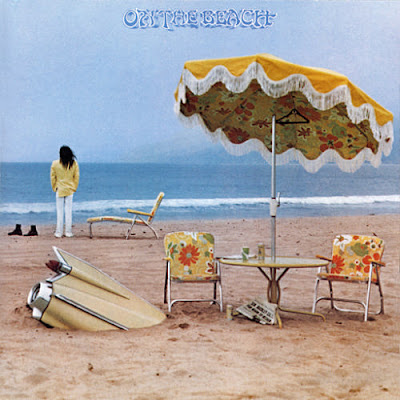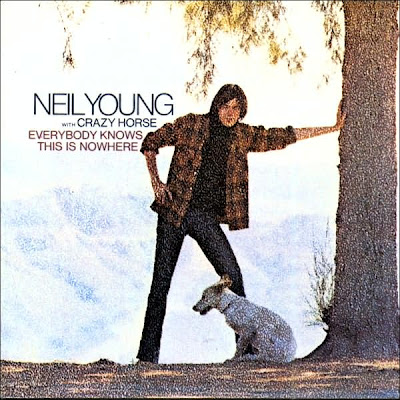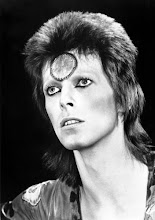
Neil Young is sometimes visionary, sometimes flaky, sometimes both at once, but he is seldom boring. Indeed, Young has weathered runs of critical and popular ambivalence only to be vindicated by being periodically "rediscovered" by younger musicians and fans. He has maintained a large following since the early 1970s with music in three basic styles — solo acoustic ballads, sweet country rock, and lumbering garage rock (with some experimental side trips), all topped by his high voice — and he veers from one to another in unpredictable phases. His subject matter also shifts from personal confessions to allusive stories to bouncy throwaways. A dedicated primitivist, Young is constantly proving that simplicity is not always simple.

Young, as a child, moved with his mother Rassy Ragland to Winnipeg, Canada, after she divorced his father Scott Young, a well-known sports journalist and author. Neil played in several high school rock hands, including the Esquires, the Stardusters, and the Squires. He also began hanging out in local folk clubs, where he met musicians Stephen Stills and Joni Mitchell. Mitchell wrote "The Circle Game" for Young after hearing his "Sugar Mountain." In the mid-1960s Young moved to Toronto, where he began performing solo. In 1966 he and bassist Bruce Palmer joined the Mynah Birds (which included Rick James and had a deal with Motown Records); after that fizzled, he and Palmer drove to L.A. in Young's Pontiac hearse. Young and Palmer ran into Stills and another mutual friend, Richie Furay, out west and formed Buffalo Springfield, one of the most important new folk-country-rock bands, who recorded Young's "Broken Arrow," "I Am a Child," "Mr. Soul," and "Nowadays Clancy Can't Even Sing." But friction developed: Young quit the band, only to rejoin and quit again, and in May 1968, after recording three albums, the band split-up.


Young acquired Joni Mitchell's manager, Elliot Roberts, and released his debut solo self-titled LP in January 1969, co-produced by Jack Nitzsche. Around the same time Young began jamming with a band called the Rockets, renamed Crazy Horse: drummer Ralph Molina, bassist Billy Talbot, and guitarist Danny Whitten. They backed Young on Everybody Knows This Is Nowhere (Number 34, 1969), recorded in two weeks. The album contains three of Young's most famous songs: "Cinnamon Girl," "Down by the River," and "Cowgirl in the Sand," which Young later said were written in one day while he was stricken with the flu. The album went gold (and much later, platinum), but Young decided to split his time between Crazy Horse and Crosby, Stills & Young, whom he joined in June. In March 1970 his presence was first felt on Crosby, Stills, Nash & Young's Déjá Vu.



Young's third solo album, the utterly evocative After the Gold Rush (Number 8, 1970), included Crazy Horse and 17-year-old guitarist Nils Lofgren. The album went gold and yielded the single "Only Love Can Break Your Heart" (Number 33, 1970), and that plus the CSN&Y album put the spotlight on Young. Harvest (Number One, 1972) was written largely while Young was recuperating from a slipped disc and recorded with a studio assemblage dubbed the Stray Gators; it featured the Number One single "Heart of Gold" and made the singer-songwriter a superstar.

By the release of their live album, Four Way Street, in spring 1971, CSN&Y had broken up. In 192 Young made a cinema vérité film, Journey Through the Past, directing under the pseudonym Bernard Shakey; the film and its soundtrack we're panned by critics. Young confused fans further with Time Fades Away (Number 22, 1973), a rough-hewn live album recorded with the Stray Gators, including Nitzsche (keyboards), Ben Keith (pedal steel guitar), Tim Drummond (bass), and John Barbata (drums). In June 1975 Young released a bleak, ragged album recorded two years earlier, Tonight's the Night (Number 25). The album's dark tone reflected Young's emotional upheaval following the drug deaths of Crazy Horse's Danny Whitten in 1972 and CSN&Y roadie Bruce Berry in 1973. In November 1975 Young released the harder-rocking Zuma (Number 25), with Crazy Horse, an emotionally intense work that included the sweeping "Cortez the Killer." Crazy Horse now included Talbot, Molina, and Frank "Poncho" Sampedro (rhythm guitar). In 1976 Young recorded Long May You Run (Number 26) with Stills, which went gold, but he left Stills halfway through a tour, informing him via telegram.

In June 1977 Young was back on his own with the gold American Stars 'n Bars (Number 21), again a more accessible effort, with Linda Rondstadt doing backing vocals along with newcomer Nicolette Larson. Compiled by Young, the three-LP Decade was a carefully chosen, not entirely hit-centered compilation. Comes a Time (Number 7, 1978) was folkish and went gold.

In fall 1978 Young did an arena tour called Rust Never Sleeps performing half the show on solo piano or guitar and the other half (which was memorably loud) with Crazy Horse, amid giant mock-ups of microphones and speakers. In June 1979 he released Rust Never Sleeps (Number Eight) with songs previewed on the tour, including "My My Hey Hey (Out of the Blue)," which paid lyrical tribute to the Sex Pistols' Johnny Rotten. (The same song was reprised at the end, as "Hey Hey My My [Into the Black].") The album also featured "Sedan Delivery" and "Powderfinger," which Young had once offered to Lynyrd Skynyrd, though the band didn't record them. (Back in 1974 Skynyrd had written "Sweet Home Alabama" as an answer to Young's "Southern Man," from After the Gold Rush.) In November 1979 Young released the gold Live Rust (Number 15), a double-LP culled from the fall 1978 shows and the soundtrack to a film of the tour (directed again by "Bernard Shakey"), entitled Rust Never Sleeps.

The 1980s were a particularly strange and erratic decade for Young, even by his own unpredictable standards. Right before presidential election week in 1980, he issued Hawks and Doves (Number 30), an enigmatic state-of-the-union address, with one side of odd acoustic pieces and the other of rickety country songs. A year later he released Re*ac*tor (Number 27), an all-hard-rock LP. In 1982 he moved to Geffen and released Trans (Number 19), which introduced what Young called "Neil 2"; he fed his voice through a computerized Vocoder and sang songs like "Sample and Hold." He toured arenas as a solo performer when the album was released, singing his most-requested sogns, covering "backstage" action on a large video screen, and singing along with his Vocoderized video image on songs from Trans.

Young's wandering got more extreme with Everybody's Rockin', a rockabilly album recorded and performed with a group he dubbed the Shocking Pinks. Despite an amusing video for the song "Wonderin'," Young's work started sliding down the charts. Old Ways was a country record with guest spots by Willie Nelson and Waylon Jennings. Landing on Water used synthesizers on standard rock songs. Life reunited Young with Crazy Horse in lackluster performances. After his disastrous relationship with Geffen — in which he was ultimately slapped with a $3 million suit for making "unrepresentative," noncommercial music — Young returned to his former label Reprise for This Note's For You, a horn-based blues/R&B album. The video for the title song attacked rockers who allowed their songs to be used in TV ads and was not shown on MTV, although it earned the network's Music Video Award for Best Video of the Year. In 1987, after appearing with his old cohorts in CSN at a Greenpeace benefit, Young rejoined the group briefly for the 1988 CSN&Y album American Dream (Number 16). None of Young's 1980s albums was particularly well received beyond the artist's loyal core audience, though some — such as Trans— had captured critics' interest. Many wrote off his 1980s period as typical Neil Young flakiness.

But there were events n Young's personal life that shed light on his increased eccentricity. In 1978 his second son, Ben, was born to his wife Pegi, with cerebral palsy (in 1972, Young's first song, Zeke, was born to his then-companion, actress Carrie Snodgress, with a milder version of the disorder). Later, in a 1992 interview with The New York Times, Young said his 1980s output had reflected his frustration with not being able to communicate with Ben: "Trans signified the end of one sound and era and the beginning of another era, where I was indecipherable and no one could understand what I was saying."

Young's extramusical activities during the 1980s were as unpredictable as his albums. In 1984, to the bewilderment of his fans, he spoke out in favor of conservative Ronald Reagan. He also participated in the 1985 Live Aid benefit and helped organized the subsequent Farm Aid concerts. In 1986 Young and his wife started the Bridge School in San Francisco, a learning center for disabled children. In 1989 a group of alternative rockers, including Sonic Youth, the Pixies, and Dinosaur Jr., contributed to The Bridge: A Tribute to Neil Young, whose proceeds went to the school. Young also organized an annual benefit concerts for the school.

Hailed by a new generation of post-punk musicians as the Godfather of Grunge, Young had a major comeback beginning in 1989 with Freedom (Number 35), his biggest charter since Trans, as well as his biggest critical hit in a decade. He introduced its single, "Rockin' in the Free World," in an unbridled, transcendent 1989 performance on Saturday Night Live — one of the greatest moments in all of rock television. Young then regrouped Crazy Horse for Ragged Glory (Number 31, 1990), a raucous, lauded album. With raw, feedback- and distortion-drenched garage rock, the album proved the extent of Young's influence on younger alternative-rock bands such as Dinosaur Jr. and Pearl Jam. In 1991 he embraced the new generation of bands by taking noise-rockers Sonic Youth and Social Distortion on the road; the tour was documented on Weld (whose 35-minute instrumental companion Arc featured extended, noisy feedback jams). Young also began praising rap, particularly the music of Ice-T.

Reuniting him with members of the Stray Gators, Harvest Moon (Number 16, 1992) found Young doing his sentimental acoustic/folk songs again. A sequel to Harvest, it was his biggest seller in 13 years. In 1992 Young appeared at the 50th birthday celebration for Bob Dylan, covering Dylan's "Just Like Tom Thumb's Blues" and "All Along the Watchtower." Released in 1993, Lucky Thirteen compiles Young's Geffen material, and Unplugged documents his live, acoustic performances following the release of Harvest Moon.
In 1994 Young contributed the haunting title song to Jonathan Demme's film Philadelphia, which was nominated for an Oscar. (Bruce Springsteen's "Streets of Philadelphia," also from the film, won.) Young also released Sleeps with Angels (Number 9, 1994), one of his strongest, most consistent, and critically lauded albums.

He was inducted into the Rock and Roll Hall of Fame in 1995 by Eddie Vedder of Peral Jam, who thanked Young for teaching his band a lot about "dignity, commitment, and playing in the moment." The mutual admiration between the artists resulted in the collaboration Mirror Ball (Number 5, 1995), with Pearl Jam backing Young on his highest-charting album since 1972. The next year he was back with Crazy Horse for Broken Arrow (Number 31, 1996). Young recorded a haunting electric-guitar score for New York independent filmmaker Jim Jarmusch's 1996 film Dead Man. Jarmusch then made a documentary of Young, Year of the Horse, released in 1997. Footage from Young and Crazy Horse's 1996 tour was spliced together with older stock from 1976 and 1986; interviews with Young, band members, crew, and associates run throughout. A soundtrack album was also released. Young headlined the H.O.R.D.E. summer festival tour in 1997. In the late-1990s, Young, a lifelong model train enthusiast, bought the Lionel Toy Train company, reportedly to delight his son Ben.
In 2000 Young released Silver & Gold, a pensive, largely acoustic album featuring drummer Jim Keltner, bassist Donald "Duck" Dunn, Ben Keith on pedal steel and Dobro, and keyboardist Spooner Oldham. Also that year, writer Jimmy McDonough filed a $1.8 million suit against Young alleging that the singer refused to allow publication of a biography written by McDonough that Young originally authorized; the book came out in 2002 as Shakey to widespread praise. In November 2000, Young released Road Rock (Number 169), a live set featuring a duet with Chrissie Hynde on "All Along the Watchtower." In the aftermath of the September 11, 2001 terrorist attacks on America, Young recorded a single, "Let's Roll," in tribute to the passengers and crew of Flight 93, and he performed a version of John Lennon's "Imagine" during a telecast benefitting victims of the attacks. "Let's Roll" appeared on 2002's Are You Passionate?, a low-key album with Booker T. & the MG's backing Young.
In 2003 he released Greendale, a concept album recorded with two-thirds of Crazy Horse (Sampedro sat out); he also made a film based on the album ("Bernard Shakey" directed again), and mounted a stage version that toured North America, Japan, and Australia. In March 2005, Young suffered a brain aneurysm and underwent a successful surgery. Around the same time, he wrote and began to record what became Prairie Wind, released late in September. The following year, Jonathan Demme's film of Young at the Ryman Auditorium in Nashville, Heart of Gold, premiered and was released to theaters. In late April 2006, Young made Living with War, a blunt protest album, available on the Web before issuing the CD in early May; its songs included the unblinking "Let's Impeach the President." He also reunited with Crosby, Stills & Nash for a U.S. tour, during which Living with War was showcased in concert.

Young's "Archives" series — spanning his entire recording career, and highlighting the many discarded albums and live recordings Young made but never released — has been mooted for so long it's become a joke in rock circles. But in late 2006 he finally began to make good on the promise, releasing Live at the Fillmore East, a much-bootlegged show recorded in 1970; in March 2007, he released Live from Massey Hall 1971, an acoustic set at a theater in Toronto. Speaking of unreleased Neil Young albums, October 2007's – Chrome Dreams II not only featured a handful of songs Young had scrapped years earlier (notably "Ordinary People," an 18-minute monster from the late 1980s), it was also titled as a sequel to a 1977 album Young had never finished.
Various Videos Of Neil Young
Neil Young - Heart Of Gold Live Video
Neil Young - Down by the river Live Video(1969)
Neil Young - Like A Hurricane Live Video
The Neil Young - Needle & The Damage Done (live)
Rock On Music Lovers!!
-Stereo
If you liked this article then make sure you subscribe to the feed via RSS It's Free. You can also follow me on Twitter too!
Check out the Retro Rebirth Design Catalog


No comments:
Post a Comment